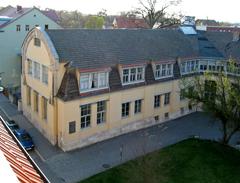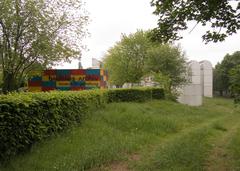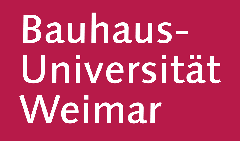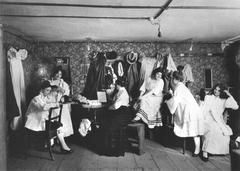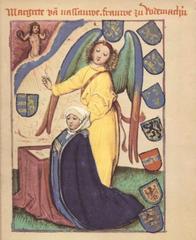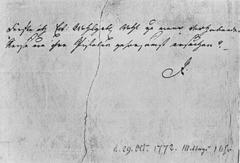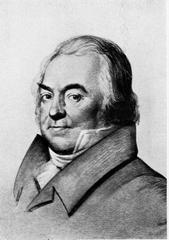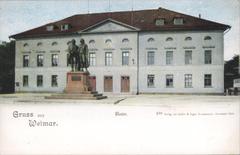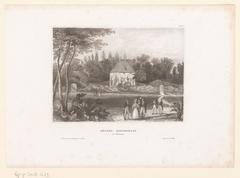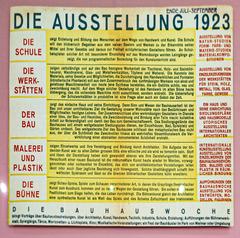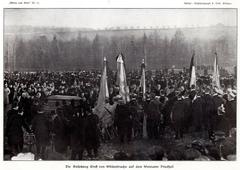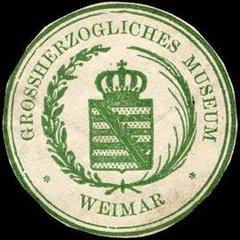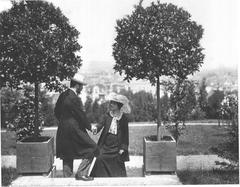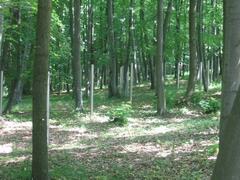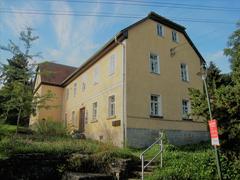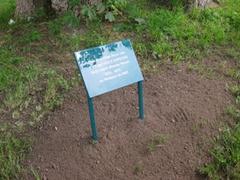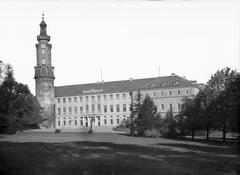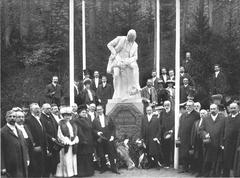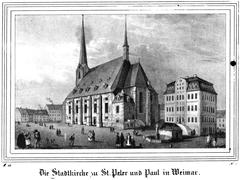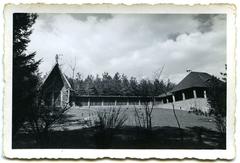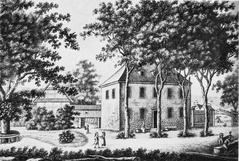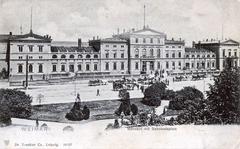
Römisches Haus Weimar: Visiting Hours, Tickets, and Historical Significance
Date: 04/07/2025
Introduction
Situated in the heart of Weimar’s verdant Park an der Ilm, the Römisches Haus (Roman House) stands as a testament to late 18th-century German Classicism and Enlightenment ideals. Built between 1791 and 1798 as the summer residence for Duke Carl August of Saxe-Weimar-Eisenach, this neoclassical villa reflects the era’s pursuit of harmony, beauty, and intellectual engagement. Its design—shaped by architect Johann August Arens and profoundly influenced by Johann Wolfgang von Goethe’s Italian journey—draws upon ancient Roman motifs, notably in its imposing Ionic portico and symmetrical layout. As a key element of the UNESCO World Heritage Site “Classical Weimar,” the Römisches Haus remains a focal point in Weimar’s landscape of culture, arts, and history (Klassik Stiftung Weimar; Wikipedia; UNESCO).
This detailed guide provides essential information for visitors—including opening hours, ticketing, accessibility, and travel tips—while also exploring the villa’s historical and cultural significance. Whether you are a history enthusiast, architecture lover, or simply a curious traveler, the Römisches Haus offers insights into Weimar’s rich legacy.
Origins and Architectural Vision
Commissioned by Duke Carl August, the Römisches Haus was conceived as a model of German Classicism. Architect Johann August Arens, influenced by Goethe’s passion for antiquity, designed the villa as a refined retreat that would embody Enlightenment principles of rationality and beauty. The site’s strategic location on a bluff provides panoramic views of the Ilm valley, mirroring the placement of Roman villas in the Italian countryside, and visually connects with Goethe’s Gartenhaus across the river (frage.de; komoot.com).
Goethe’s Influence
Goethe’s Italian journey (1786–1788) profoundly shaped his aesthetic ideals. Upon his return, he became an advisor and overseer for the Römisches Haus project, ensuring that the house’s architecture and gardens reflected classical antiquity and integrated harmoniously with the landscape. His involvement extended from the overall concept to the details of the park’s layout, reinforcing the Enlightenment belief in the unity of art and nature (Weimar-Lese; quermania.de).
Patronage and Early Use
Duke Carl August’s patronage fostered the cultural flowering of Weimar, attracting figures such as Goethe and Friedrich Schiller. The Römisches Haus served as both a leisurely summer residence and a venue for intellectual salons, symbolizing the alliance of enlightened governance and artistic achievement (quermania.de). After the Duke’s death, the house saw periods of neglect before restoration and its eventual opening to the public as a museum of Weimar Classicism (weimarmeinestadt.de).
UNESCO World Heritage Status
The Römisches Haus is integral to “Classical Weimar,” a UNESCO World Heritage Site since 1998, recognized for its outstanding representation of German Classicism and Enlightenment culture. Alongside landmarks like Goethe’s Gartenhaus and the Park an der Ilm, it encapsulates Weimar’s intellectual and artistic achievements (UNESCO; welterbedeutschland.de).
Architectural and Artistic Highlights
The villa’s façade, with its four Ionic columns and temple-like silhouette, exemplifies early German Neoclassicism. Inside, the main vestibule, Blue Salon, and Yellow Salon (the Duke’s study) are adorned with antique-inspired stucco, painted panels, and elegant furnishings. The interiors were designed by Christian Friedrich Schuricht and Johann Heinrich Meyer, while sculptor Martin Gottlieb Klauer contributed to the decorative reliefs and pediment (Weimar-Lese; Wikipedia; Trek Zone).
The house’s position forms a visual axis with Goethe’s Gartenhaus, exemplifying the integration of architecture and landscape—a core value of Weimar Classicism (Lonely Planet).
Museum Layout and Exhibitions
Today, visitors can explore a series of restored rooms furnished to evoke the late 18th-century court, including the main salon, study, and veranda. Exhibitions, both permanent and temporary, interpret Goethe’s influence, the rise of Neoclassicism, and the cultural significance of the villa. Multimedia displays and interpretive panels offer context within the broader UNESCO “Classical Weimar” ensemble (Weimar-Tourist).
Visitor Information
Opening Hours
- April–October: Wednesday to Monday, 10:00–18:00; closed Tuesdays.
- November–March: Closed (or open only for special events; check the official website for updates). (Klassik Stiftung Weimar)
Tickets and Admission
- Admission: Free for all visitors.
- Weimar Card: The Römisches Haus is included in the Weimar Card, which grants access to many local attractions. As of 2025, the card costs €32.50 for 48 hours (weimarmeinestadt.de).
Accessibility
- The villa is located on a hill within Park an der Ilm, accessible via well-maintained park paths. Some interior spaces have limited accessibility due to the building’s historic nature. Ramps and handrails are available where feasible, and assistance is recommended for visitors with mobility challenges (komoot.com; museum.com).
Getting There
- Location: Park an der Ilm, 99423 Weimar.
- Access: Approximately a 10-15 minute walk from Weimar’s city center; also reachable by local bus. GPS coordinates: 50.97122 N, 11.33548 E (quermania.de).
Facilities
- Restrooms and a small gift shop are available.
- No café on-site, but nearby options are within walking distance. Picnics in the park are popular.
Guided Tours and Educational Programs
- Guided Tours: Offered seasonally, focusing on Weimar Classicism, the villa’s history, and its artistic legacy. Available in multiple languages; check the official website for schedules.
- Self-Guided Visits: Multilingual audio guides are available; the Weimar+ App or Audiala app can be used for on-site or remote exploration.
- Educational Programs: Workshops and lectures for school groups and adults are regularly held, especially during cultural festivals.
Special Events and Seasonal Highlights
The Römisches Haus is a venue for classical concerts, readings, and themed tours, particularly during Weimar’s cultural festivals such as “Weimar Summer.” Exhibitions often highlight landscape architecture and the intellectual circles that gathered here (welterbedeutschland.de).
Nearby Attractions
Enhance your Weimar itinerary with a visit to:
- Goethe’s Gartenhaus (9-minute walk)
- Duchess Anna Amalia Library
- Weimar City Palace
- Bauhaus Museum Weimar
- Stadtschloss Weimar
Practical Tips for Visitors
- Footwear: Comfortable shoes are recommended for park walks.
- Weather: Plan your visit for fair weather; bring rain gear if necessary.
- Photography: Non-flash photography is allowed inside; tripods are not permitted.
- Time Allocation: Allow 60–90 minutes for the museum, plus additional time to explore the park.
Frequently Asked Questions (FAQ)
Q: What are the opening hours?
A: April–October: Wednesday–Monday, 10:00–18:00. Closed Tuesdays and during winter months.
Q: Is there an admission fee?
A: Entry is free.
Q: Is the villa wheelchair accessible?
A: Partial accessibility; some paths and interiors may be challenging. Assistance is available.
Q: Are guided tours offered?
A: Yes, seasonally and by reservation.
Q: Can I take photographs inside?
A: Yes, but no flash or tripods.
Q: How do I reach the Römisches Haus?
A: Walk from the city center or use local buses; located in Park an der Ilm.
Enhance Your Visit
- Explore the official Römisches Haus gallery for images and virtual tours.
- Download the Weimar+ or Audiala app for guided audio experiences.
- Follow Klassik Stiftung Weimar and related social media channels for updates on events and exhibitions.
Conclusion
The Römisches Haus Weimar is more than a neoclassical villa—it is a living monument to the Enlightenment spirit and artistic innovation that shaped Weimar’s unique cultural heritage. Its harmonious integration with Park an der Ilm, connection to Goethe, and role in Weimar Classicism make it an essential stop for any visitor. With free admission, thoughtfully curated exhibitions, and seasonal events, the Römisches Haus welcomes all who wish to experience the legacy of Germany’s classical era.
For a deeper exploration, combine your visit with other UNESCO-listed sites in Weimar and enrich your journey through curated audio guides and events.
References
- Klassik Stiftung Weimar
- Wikipedia – Römisches Haus (Weimar)
- frage.de
- Weimar-Lese
- Lonely Planet
- UNESCO
- welterbedeutschland.de
- quermania.de
- weimarmeinestadt.de
- ADAC Maps
- Trek Zone
- Weimar-Tourist
- museum.com

